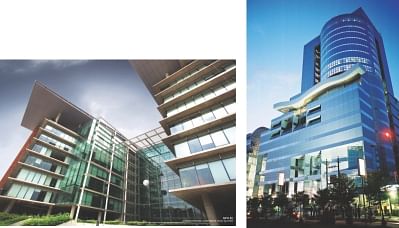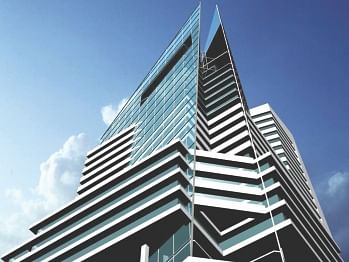| Home - Back Issues - The Team - Contact Us |
 |
| Volume 11 |Issue 36| September 14, 2012 | |
|
|
Architecture A Modernist Architect Takir Hossain
Mustapha Khalid Palash is one of the most illustrious names in the territory of contemporary architecture of Bangladesh. His novel and refreshing approach towards architecture makes him peerless or practically singular in our country. His constructions are noted for their modern style, and verge on experimentalism. He has designed many mega buildings in different categories like corporate offices, hotels, hospitals, residential apartments and more. The recurrent feature of his architectural work is plain view and easy accessibility of air and light. Above all, his work carries a modern touch and has proportional quality. His novel touch and distinct features in architecture have taken the capital city to a different dimension by creating aesthetic, sustainable and functional architecture, constructed one after another for the last one and a half decades. He uses glass and aluminum extensively in his works. He has a balanced and rational approach towards the use of space. One can feel like he/she is outdoors when entering one of his buildings. His use of water in his projects is also environment friendly. “Treading towards architecture, I have fallen in love with art. I was fond of art from my childhood,” says Palash. “I did not want to become an architect. I wanted to become a painter. But I was familiar with the financial hardships they face, as both of my parents were painters. I can't tell you how many times I heard the reprimand, 'Stop doodling and get to work', when I was a child,” he continues. He is now the Managing Director of Vistaara Architects Ltd and chairman of the Delvistaa Foundation. During his childhood, architecture did not draw Palash's attention as an art form. When he was in class eight, he made a model of an airport just by looking at a picture of an airport. That's how Palash became attracted to architecture and eventually became an architect. He says, “I never understood what architecture was; I got myself involved in architectural designs in my boyhood without even realising.”
Palash graduated from the Department of Architecture, Bangladesh University of Engineering and Technology (BUET) in 1988. In 1994, he joined the department as a teacher and taught there for about five years. In 1998, he opened his own architectural design firm. During 1988-1999, he spent his career as a professional architect and teacher. The most significant event at that time was his trip to Japan where he gained many experiences and watched different technical aspects of architecture. During that visit, he saw some projects by Tadao Ando, a veteran architect of Japan. He noticed the Japanese construction technology as well. That was an eye opener for him. It is very significant that during his student years he took architecture assignments. The talented architect says, “I don't know how much of the urge to create architecture was there. Later when I started teaching, I always thought that I was working with a group of researchers which helped me gain my practical experience. In the initial stage, there was a lack of maturity which each and every architect faces. That maturity came to me after ten years." About Palash's architecture and his mode of expression, prominent architect Shamsul Wares says, “Palash's works carry the attitude of modern architecture.There is no decoration or ornamentation in his work.” Wares also feels that transparency and ample light, both are vital features in his work. The distinctness of his work is easily noticeable. His works don't have any complexity; his language is simple, easily understandable, communicable and accessible, according to Wares. For this reason, one can easily appreciate his creations. From the street, his works look very inviting, attractive and appealing. Pedestrians enjoy the urban texture in the metropolitan setting. “Air, light and proportion are easily articulated in his work. He is also conscious about our climate and weather. But his works look impersonal; our culture as well as historical elements need to be connected to his work,” he opines.
Palash feels that the number of non-commercial architecture such as museums, art galleries, educational institutions and libraries, is very insignificant in our country. The genres of architecture we see are very few. He thinks that the state should act as a patron to this field more in the future. He adds that the art of architecture of our country is now fully depended on developers and corporate houses. “Developers usually take help from architects for the sake of their own benefit. The profession of architecture is now a full-fledged one but the representation is not quite fair,” he says, “Public buildings are neglected.” He also points out the fact that architects are very busy with commercial structures nowadays and that commercial ventures are more visible in the city. “The government should encourage talented architects to articulate their creativity and artistic endeavours.” Grameenphone Corporate Head Quarter is one of the good examples of modern architecture that Palash designed. This project received the Holcim Green Award. About the project, Palash says, “The project features two complementary office wings, one being aligned with western boundary, resulting in a gentle asymmetry in composition and connecting a central communal space of courtyard of link-bridges, elevators and stairs.” The symbolism and modernity in his work are based upon a contemporary interpretation of the context, our culture, values and history. Grameenphone Corporate Head Quarter thus, has the potential for becoming a new example of a more contemporary, climate and ecologically and socially responsive design. “The design is civic-minded in its creation of the plaza at the civic interface, and in its detailed attention to its immediate landscape—water, central courtyard, and garden at the extreme south,” he says. Beyond his architectural practice, Palash also paints, writes and plays the sitar. He has taken a sitar course at Chhayanaut. Colour, brush, canvas – these have been his close companions since childhood. He has written short stories and poems for small time magazines and literary journals. At that time, illustration was his preferred form of art. He did many illustrations. At the age of 16, Palash had his first painting exhibition. The exhibition was inaugurated by renowned artist Quamrul Hassan, in 1978. Since the late '80s, Palash has been active in the Bangladeshi art circles. Many of his solo exhibitions were held in different galleries in the city. Palash is usually very busy. He sketches either when having long telephone conversations or during boring meetings. He likes to draw when he is chatting with someone. He does it without any specific intention. Use of colour is the major aspect of his acrylic based paintings. Vivacious colours and fragmented shapes give his works a kaleidoscopic appearance. His works look animated and dynamic because of the use of thick, abundant colours and evocative lines. As an admirer of nature, Palash portrays deep forests, bringing out their mystical beauty. He feels that nature helps us explore our identity and existence. His individual view of nature is distinct because of its quiet and silent appearance. Palash's notable designs include Bashundhara City (Pantapath), Grameenphone Corporate Head Office (Bashundhara) , Eastern Bank Head Headquarter (Gulshan), BTI Land Mark (Gulshan), JAS Cube (Gulshan), Rangs Sultan (Dhanmondi) Banglalink Head Office, the Robi Head Office, Radisson Bay View Hotel (Chittagong), The Westin Hotel (Gulshan), and the Lab Aid Cardiac Care Hospital (Dhanmondi) , Shanta Western Tower (Tejgaon-Gulshan Link Road), Yunusko Tower (Chittagong), PICL Headquarter (Motijheel) and more. Palash received several national and international awards among which are the IAB Design Award 1998, Architect of the Year 2005 (India), Burgers Award for Excellence on Architecture 2007, Holcim Green Built Bangladesh Prize 2010, Shilpacharya Puroshkar 2011 and more. His works have been reviewed in several national and international magazines including the McGraw-Hill publication, Dezeen Magazine, POL Oxygen, and many others.
Copyright
(R) thedailystar.net 2012 |
||||||||||||||


